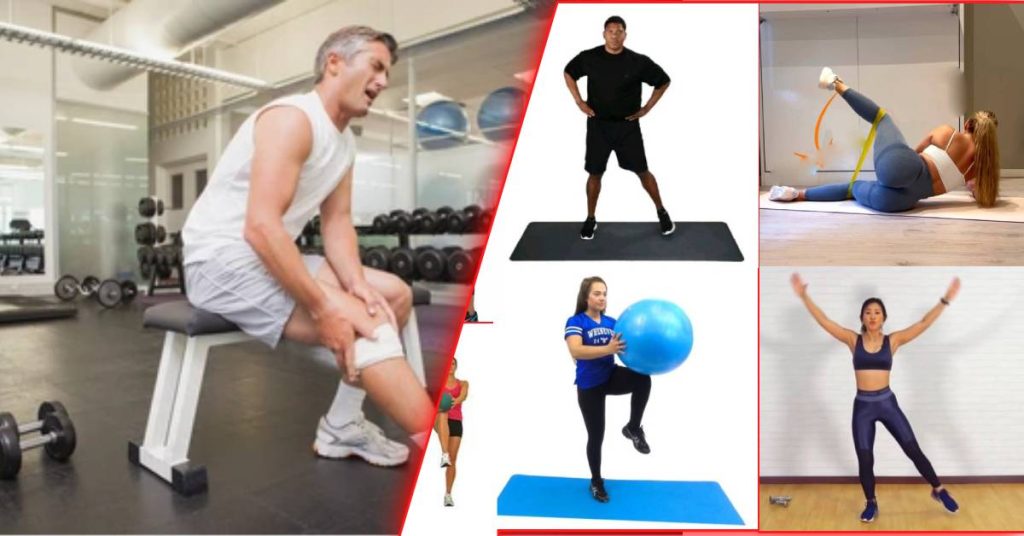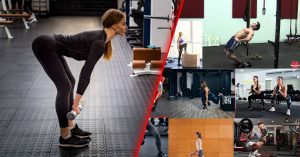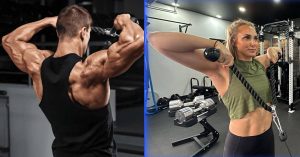When knee pain becomes a daily companion, it might feel like your favorite cardio routines are now out of bounds. The mere thought of running or jumping might make your knees quiver. But here’s a burst of good news: the best cardio exercise with bad knees is not just a hopeful wish; it’s a reality waiting for you to discover.
This guide is more than just a collection of exercises; it’s your golden ticket to a cardio routine that celebrates your strengths and respects your limits. Ready to embark on this journey?
Table of contents
MORE keyboard_double_arrow_down LESS keyboard_double_arrow_up
The Importance of Consulting Healthcare Professionals For Knee Pain
Living with knee pain and maintaining an active lifestyle requires careful consideration. It’s important to approach exercise with caution, ensuring that each step is taken with care. Before starting any new workout routine, it’s essential to consult healthcare professionals for guidance.
Consulting with healthcare professionals before embarking on a new exercise regimen is vital for several reasons. Firstly, they can provide personalized guidance tailored to your unique knee condition.
Since every individual’s situation is different, having a plan specifically designed for your needs maximizes the effectiveness of your workouts while minimizing the risk of exacerbating any existing issues.
Additionally, seeking professional advice ensures safety during exercise. Without proper guidance, there’s a heightened risk of further injury, akin to navigating a minefield blindfolded.
Lastly, consulting with healthcare professionals helps you prioritize long-term knee health. By choosing the appropriate exercises and techniques, you’re not only alleviating current pain but also investing in the future well-being of your knees.
This proactive approach ensures that you can enjoy an active lifestyle for years to come while minimizing the likelihood of recurring pain or injury.
Optimal Gym Machines for Sensitive Knees
The gym offers plenty of knee-friendly exercise options, with two standout choices being the stationary bike and the elliptical machine.
These machines are great for people dealing with knee pain because they provide a way to get in a good cardio workout without putting too much stress on the knees. However, it’s important to use them correctly to reap the most benefits while avoiding any potential risks.
When it comes to the stationary bike, it’s crucial to set it up properly for your body. Start by adjusting the seat to a height where your knee has a slight bend when the pedal is at its lowest point. This setup helps reduce strain on the knees.
Begin your workout with a gentle warm-up at a low resistance level, gradually increasing it as your muscles loosen up. Additionally, there might be specific cycling techniques that can further decrease strain on the knees, which are worth exploring.
As for the elliptical machine, focus on maintaining good posture throughout your workout. Stand tall with your shoulders back, allowing your legs to do the majority of the work. The aim is to mimic the natural movement of your legs as much as possible. Adjust the resistance and incline settings to challenge yourself without putting too much pressure on your knees.
By following these tips and paying attention to your body’s signals, you can make the most of your time on the stationary bike and elliptical while keeping your knees happy and healthy.
The Ultimate Home Cardio Routine for Knee Pain
Even without a gym membership, you can achieve a great workout at home with minimal equipment. This is perfect if traditional options aren’t your style. For instance, recumbent exercise bikes offer a low-impact alternative for cardio that’s gentle on the knees.
The following workout provides a variety of low-impact exercises specifically designed to elevate your heart rate while minimizing stress on your joints, especially your knees.
Step Touches
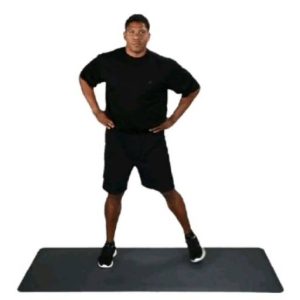
Step touches are a cornerstone of low-impact cardio, perfect for getting your heart rate up without putting pressure on your knees.
Here’s how to do it:
- Start tall with your feet hip-width apart and arms by your sides.
- Take a wide step to the right, reaching your arms out to the sides for an energizing opening.
- Quickly bring your left foot in, tapping it lightly beside your right foot. Don’t squat or lunge – keep your legs relatively straight for a continuous flow.
- Immediately step out to the left with your left leg, reaching your right arm out to the side as your left arm swings back.
- Continue this side-to-side stepping motion, gradually increasing the width of your steps and the reach of your arms to warm up your entire body. Imagine yourself becoming a human metronome, picking up the pace!
- Maintain this energetic step touch for 60 seconds. If you’re new to the exercise, start with 30 seconds and gradually build your endurance.
Try these variations:
- Step touch all the way across the room and back for an added challenge.
- Boost your upper body workout by circling your arms overhead with each step.
- Want to focus on balance? Stay on your right leg and step the left foot out to the side and back in for 30 seconds. Repeat on the other leg.
Low-Impact Jumping Jacks

Low-impact jumping jacks offer all the cardio benefits without the strain on your knees. It sounds like a dream, but it’s entirely possible with the right technique. Instead of jumping, you step one foot out at a time while raising your arms. This version maintains the heart-pumping essence of traditional jumping jacks.
Here’s how to do it:
- Stand tall with your feet hip-width apart and arms by your sides.
- Take a bold step out to the right with your right leg, reaching your right arm up overhead in a diagonal line as if reaching for a star. At the same time, gently twist your torso to face the side of the room where your right leg is extended.
- Step back to the starting position and immediately pivot your body to face the other direction. Extend your left leg out to the side and swing your left arm up overhead in a mirror image of the previous movement.
- Continue this alternating twisting lunge for 60 seconds, feeling your core muscles engage with each twist. If you’re new to the exercise, start with 20-30 seconds and build your stamina.
variations:
- Instead of a single arm raise, add a flourish! Swing both arms overhead together, making large circles as if drawing a rainbow in the air.
- Feeling energetic? After stepping out to the side, explode into a full jumping jack before coming back to the twisting lunge. Make sure your knees feel comfortable with this variation.
- If pivoting bothers your knees, simply extend your legs out to the sides without twisting your torso. You’ll still get a great core workout!
March with an Exercise Ball
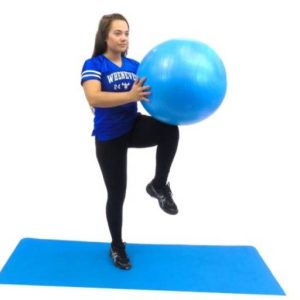
The exercise ball is a versatile tool that adds an element of stability training to your cardio, engaging your core, and improving balance. Using an exercise ball for exercises like ball squats or “ball jacks” can significantly reduce the load on your knees. Imagine the possibilities: from seated ball marches to dynamic ball squats, the options are endless.
Here’s how to do it:
- Grab your exercise ball and stand tall with it held in front of you, arms straight.
- Lift your right knee up high towards your chest. At the same time, bring the exercise ball down to gently tap your right knee. Imagine you’re giving your knee a hug with the ball!
- Lower your right leg back down and raise the ball back up to starting position. Now, repeat the move with your left leg, bringing the ball down to tap your left knee.
- Keep this marching hug going for 60 seconds, feeling the burn in your quads (front thigh muscles). If you’re new to the exercise, start with 20-30 seconds and build up your endurance.
Variations:
- If holding the ball straight out is tiring your arms, simply hug it to your chest as you march your knees.
- Feeling strong? Speed up your marching knee hugs for a more intense workout.
- No exercise ball? No problem! You can still do this exercise by simply marching your knees up high and tapping your hands to your knees instead.
Medicine Ball Knee Lifts
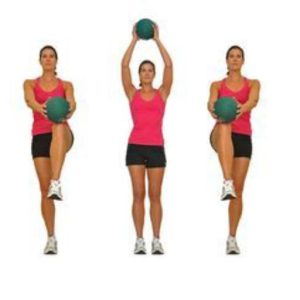
Incorporating a medicine ball into knee lifts not only elevates your heart rate but also adds an extra layer of challenge to your workout. This tool allows for a variety of movements that can enhance strength, balance, and coordination all while being mindful of knee health. The key is to maintain control and ensure proper form.
Here’s how to do it:
- Hold the medicine ball firmly in both hands in front of your chest.
- Now, get ready to march! Just like you did before, lift your right knee up high towards your chest. But this time, use the medicine ball to tap your knee as it reaches the top. Imagine you’re giving your knee a high five with the ball!
- Lower your right leg back down and bring the medicine ball back up to starting position. Now, repeat the move with your left leg, tapping the ball to your left knee.
- Keep this marching high five going for 60 seconds, feeling the extra burn in your legs and core. If you’re new to the exercise, start with 30 seconds and build up your endurance.
Variations:
- Struggling to hold the ball out front? Simply hug it to your chest as you march your knees for a less demanding upper body workout.
- Ready for a challenge? Speed up your marching knee hugs for a more intense burn.
- Feeling strong? Grab a heavier medicine ball for an extra level of difficulty.
Dynamic Leg Kicks with a Medicine Ball
Combining strength and cardio, dynamic leg kicks with a medicine ball are a powerful way to engage the entire body without overburdening the knees. The added weight of the medicine ball increases resistance, making your muscles work harder. Proper alignment and controlled movements are crucial to keep this exercise knee-friendly.
Here’s how to do it:
- Grab your medicine ball and hold it straight up overhead.
- Now, take a bold step back with your right leg, dropping into a lunge position. Bend your front knee slightly, keeping your core engaged and back straight. Imagine yourself assuming a warrior stance!
- Unleash your inner fighter! Explode upwards, kicking your right leg forward as you bring the medicine ball down forcefully towards your toes. Think of slamming a dunk in basketball, but with the medicine ball instead!
- Repeat this lunge kick for 30 seconds, feeling the burn in your legs and core. Then, switch sides and repeat the exercise with your left leg for another 30 seconds.
Variations:
- If bending your front knee is uncomfortable, simply keep it straight as you lunge back.
- Need a lower intensity option? Hold the medicine ball close to your chest throughout the exercise instead of overhead.
- Want to decrease the intensity, but still work your core? Bring your right knee up towards your chest instead of extending your leg straight out in the kick.
Medicine Ball Chest Squeeze

Blending strength training into your cardio regime with a medicine ball chest squeeze not only works your pectoral muscles but also keeps your heart rate up. This exercise can be done standing or seated, making it versatile and accessible. It’s about squeezing the ball with enough force to engage the chest muscles while maintaining a pace that contributes to your cardio goals.
Here’s how to do it:
- Stand tall with your feet hip-width apart and hold the medicine ball firmly at chest level. Imagine you’re giving the ball a big hug!
- Now, feel the power building! Squeeze the ball tightly with your palms, contracting your chest muscles as if you’re trying to crush the ball (but be gentle with it!).
- With that squeeze in mind, slowly push the medicine ball straight out in front of you, keeping it roughly at chest level. Extend your arms until your elbows are almost straight, but don’t lock them out completely.
- Feel the tension in your chest? Great! Now, slowly bend your elbows again and bring the medicine ball back to its starting position at your chest. Maintain that firm squeeze throughout the entire movement.
- Repeat this powerful press for 16 repetitions to really get your chest working. If you’re new to the exercise, start with 8 reps and gradually increase as you build strength.
Variations:
- Want to give your legs a break? Sit down on a chair with your back straight and feet flat on the floor. Perform the medicine ball press from this seated position.
- Feeling the burn a little too much? Simply hold the medicine ball tightly at chest level and squeeze it with your hands. You can skip steps 3 and 4 of pushing the ball out for a less intense variation.
Band Side Knee and Kick
Adding a resistance band to your workout not only spices things up but also introduces a low-impact, high-reward exercise suitable for those with knee concerns. By engaging your legs and core, you target key muscle groups that support knee health.
Here’s how to do it:
- Start tall with your feet hip-width apart and shift your weight slightly onto your left leg. Now, raise your arms straight up overhead, keeping the band taut.
- Time to engage your core! Squeeze your waist and lift your right knee up diagonally towards your left chest. As your knee rises, pull your right elbow down towards your knee, feeling that diagonal twist in your torso.
- Lower your right leg back down and straighten your torso to return to the starting position. Keep that core engaged!
- Repeat the movement, but this time keep your right leg straight as you lift it out to the side. Aim for a high kick, feeling the stretch in your hamstrings. Bring your left elbow down towards your raised right knee for that diagonal chop.
- Alternate between the bent knee lift and the straight leg lift for 30 seconds, feeling the burn in your obliques (sides of your core). Then, switch sides and repeat the exercise for another 30 seconds, working your left core.
A Knee Protector
Hamstring curls are not just exercises; they’re a form of therapy for your knees. By strengthening the muscles at the back of your thigh, you’re directly supporting knee stability and reducing pain.
Here’s how to do it:
- Stand tall with your back facing the chair and your feet hip-width apart. Reach behind you and lightly grasp the chair back for support, using it more for balance than weight-bearing.
- Now, let’s lift it up! Focus on squeezing your glutes as you bend your right knee and bring your foot up towards your backside in a kicking motion.
- Hold this lifted position for a second at the top, feeling the squeeze in your glutes and hamstrings. Then, slowly lower your foot back down to the floor in a controlled motion.
- Repeat this glute bridge 10 times on your right leg, really focusing on using your glutes to lift and lower your leg.
- After completing your reps on the right leg, step it down and repeat the exercise for 10 repetitions on your left leg. Aim to complete 1 to 3 sets of glute bridges on each leg for a well-rounded workout.
Variations:
- Want to add some extra fire to your workout? Wrap a resistance band around your ankles just above your calves before you begin. This will increase the difficulty as you lift your leg.
- Feeling confident in your balance? Ditch the chair for this variation! Simply perform the glute bridges lying flat on your back on the floor with your knees bent and feet flat on the ground. Lift your hips up just like you did with the chair, squeezing your glutes at the top. Remember to maintain good control throughout the movement.
Side Leg Lifts for Stability and Strength

Side leg lifts are a brilliant exercise for fortifying the muscles around your hips and thighs, which in turn, plays a significant role in supporting your knees. Integrating this into your cardio session not only aids in building stability and strength but also diversifies your workout.
Here’s how to do it:
- Extend your left leg out to the side, keeping your leg straight from hip to foot. Imagine you’re drawing a straight line in the air with your toes. Flex your foot at the ankle, pointing your toes for added engagement.
- Keep your core tight and your back straight throughout the movement. Avoid tilting your torso to the side – focus on lifting the leg purely through hip strength.
- Hold this lifted position for a second at the top, feeling the squeeze in your outer hip muscles. Then, slowly lower your leg back down to the starting position with control.
- Repeat this side leg lift 10 times on your left leg, really focusing on using your hip to lift and lower your leg.
- After completing your reps on the left leg, lower it down and repeat the exercise for 10 repetitions on your right leg. Aim to complete 1 to 3 sets of side leg lifts on each leg for a well-rounded workout.
Variations:
- Want to add some extra burn? Wrap a resistance band around your ankles just above your calves before you begin. This will increase the difficulty as you lift your leg.
- Ready for a core challenge? You can also perform this exercise lying on your side on a mat. This variation, also known as side lying leg lifts, will engage your core muscles even more as you stabilize your body throughout the movement.
Knee Lifts with Punches
Cardio-kickboxing combines the heart-pumping excitement of cardio with the dynamic movements of kickboxing, making it an exhilarating way to work out without overburdening your knees. Integrating knee lifts with punches offers a comprehensive workout that engages the whole body.
Here’s how to do it:
- This dynamic exercise will challenge your coordination and get your heart rate up. Don’t worry if it takes a few tries to master the move – give yourself some time to practice and perfect your technique!
- Imagine you’re a stealthy boxer ready to strike. Stand tall facing the corner of the room with your feet shoulder-width apart.
- Step back with your right leg as you explosively punch your right arm straight out in front of you, like a quick jab.
- As you pull your right arm back, bring your right knee up towards your chest in a quick pulling motion. Imagine you’re dodging a punch and bringing your knee up for defense. Simultaneously, punch your left arm out in a powerful cross, extending it straight across your body.
- That’s one jab-cross-knee pull! Repeat this dynamic combination for 30 seconds on this side, feeling your core engage with each twist and turn.
- After 30 seconds, lower your right leg and repeat the entire sequence for another 30 seconds, starting with a left leg step back and a left jab.
Variations:
- Want to keep it simpler? Just focus on throwing alternating punches with your arms, a jab with the right followed by a cross with the left. This is a great way to decrease the intensity and focus on your upper body coordination.
- Feeling energetic? Speed up your jab-cross-knee pull combo for an extra heart-pumping challenge.
- Want to add some extra resistance? Grab a pair of very light weights (think 1-2 pound dumbbells) to hold in each hand as you perform the punches. Remember to prioritize proper form over heavier weights.
Conclusion
Facing knee pain doesn’t mean your cardio days are numbered. It’s about shifting perspective, adapting exercises, and embracing a routine that aligns with your body’s needs. With the strategies and exercises outlined above, cardio can continue to be a rewarding part of your fitness journey, minus the knee discomfort.
By applying the techniques, tips, and considerations discussed, you can craft a personalized workout that not only respects your knee’s limits but also challenges your body and enhances your overall fitness.
So, it doesn’t matter if you’re looking for best cardio exercises for weight loss or the best cardio exercise for achilles tendonitis, the key is to listen to your body, adjust as needed, and keep pushing forward, safely and confidently.
Are you ready to take your knee-friendly cardio to new heights? Let’s embark on this journey together, exploring, learning, and growing stronger, one step at a time.
Key Points
- Knee-Friendly Cardio Options: Opt for the best exercise for cardio that offer cardiovascular benefits without putting excessive strain on the knees, such as elliptical trainers, stationary bikes, rowing machines, pool exercises, short brisk walks, and tai chi.
- Best Cardio Machine for Knee Problems: The elliptical machine is ideal for those with knee and hip arthritis, providing strengthening and cardiovascular benefits with reduced joint force.
- Exercising with Bad Knees: Engage in low-impact activities like water aerobics, biking, yoga, and walking to maintain fitness without aggravating knee pain.
- Squats and Knee Health: Squats, particularly wall squats, can be safely incorporated into a workout routine for individuals with knee issues if performed correctly, focusing on proper form and avoiding deep squats that may cause discomfort.
- Consult Healthcare Providers: Before starting any new exercise regimen, especially when dealing with knee pain, it’s crucial to consult with healthcare professionals for personalized advice and safety.
- Adapt and Modify Exercises: Listen to your body and be willing to adjust exercises as needed to ensure they are safe and comfortable for your knee condition.
- Incorporate Strength and Flexibility Training: Alongside cardio, include exercises that enhance muscle strength and flexibility around the knees to support joint health.
- Personalized Workout Plans: Create a customized workout plan that accommodates knee pain, integrating a mix of knee-friendly cardio, strength, and flexibility exercises.
- Stay Informed and Adjust as Needed: Keep informed about knee-friendly exercises and be prepared to adjust your workout plan as your fitness level or knee condition changes.
FAQs
What is the best cardio for someone with bad knees?
For those navigating knee pain, choosing the right cardio exercises is crucial to maintaining fitness without exacerbating issues. Here are some knee-friendly options:
- Elliptical Trainer: Provides cardiovascular and strengthening benefits with minimal joint strain.
- Stationary Bike: Excellent for improving endurance and muscle strength with low impact on knees.
- Rowing Machine: Engages the whole body in a low-impact manner, beneficial for knee health.
- Pool Exercises: The buoyancy of water supports your body, reducing stress on knees while allowing for a full-body workout.
- Short Brisk Walks: Offers cardiovascular benefits without the harsh impact of running or jumping.
- Tai Chi: Focuses on gentle, flowing movements to improve balance, flexibility, and strength with minimal knee stress.
What cardio machine is best for knee problems?
The elliptical machine is highly recommended for individuals with knee and hip issues, including arthritis. According to Maura Daly Iversen, professor of public health and human movement sciences, the elliptical machine is beneficial because it “provides both strengthening and cardiovascular benefits while exerting less force on the joints.”
How can I exercise with bad knees?
Exercising with knee pain requires selecting activities that minimize stress on the knee joints while still promoting flexibility, strength, and cardiovascular health. Consider the following low-impact exercises:
- Water Aerobics: The water’s resistance provides a good workout that’s gentle on the knees.
- Biking: Whether stationary or on the road, biking is effective for enhancing range of motion and building muscle without heavy impact.
- Yoga: Offers excellent flexibility training, particularly beneficial for tight areas around the knees.
- Walking: A simple yet effective way to get your heart rate up without putting undue pressure on your knees.
Are squats OK for bad knees?
Squats can be part of a knee-friendly exercise routine if performed correctly and with proper modifications. Wall squats, in particular, are a safer variation for people with osteoarthritis or other knee problems.
To ensure squats don’t harm your knees, focus on maintaining proper form and avoiding deep squats if they cause discomfort. It’s crucial to listen to your body and adjust the exercise to avoid pain.

ABOUT THE AUTHOR
Follow Valen Steven for a dose of fitness enthusiasm, evidence-based advice, and a roadmap to achieving your health and wellness goals.
Subscribe to our Newsletter
Dive into a world of fitness and wellness with our exclusive newsletter! Sign up now and receive weekly power-packs of fitness wisdom

